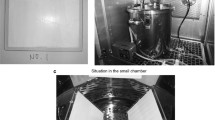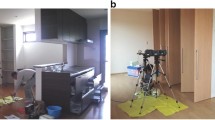Abstract
To protect public health from indoor volatile organic compounds (VOCs) exposure, it is critical to estimate the emission rate and characteristic by indoor building materials. To this end, four different types of lumbers (Pinus densiflora, Pinus koraiensis, Cryptomeria japonica, and Larix leptolepis) and four different types of artificial building materials (particleboard (PB), medium density fiberboard (MDF), plywood of Radiata Pine (PRP), and plywood of Oceania Timber (POT)) were used. Total VOC (TVOC) from lumbers, excluding P. koraiensis, showed the highest level of emissions on the first day, and the level tended to decline with the passage of time. In particular, TVOC from P. densiflora showed the highest level at 10,793 μg/m2 · h and only 40 % of TVOC reduced even after 14 days. On the other hand, TVOC from artificial building materials showed lower levels of emissions in the order of MDF > PRP > PB > POT. Furthermore, The TVOC emissions from lumbers were approximately 1.3–47.6 times higher than those of artificial building materials. However, the levels emitted from P. densiflora and P. koraiensis stabilized afterwards, and the natural VOC beneficial to the human body was confirmed to exceed 90 %, most of which comprised α-pinene, β-pinene, d-limonene, camphene, and α-terpinene.






Similar content being viewed by others
References
Brown SK (1999) Chamber assessment of formaldehyde and VOC emissions from wood-based panels. Indoor Air 9:209–215
Guo H, Murray F, Lee SC (2002) Emissions of total volatile organic compounds from pressed wood products in an environmental chamber. Build Environ 37:1117–1126
Inous S (2002) Microorganisms and aroma. Flagrance, Tokyo, ISBN 4-89479-057-2
ISO (International Organization for Standardization) 16000-9 (2004) Determination of the emission of volatile organic compounds—emission test chamber method
Komori T, Fujiwara R, Tanida M, Nomura J, Yokoyama MM (1995) Effects of citrus fragrance on immune function and depressive states. Neuroimmunomodulation 2:174–180
Kordali S, Kotan R, Mavi A, Cakir A, Ala A, Yildirim A (2005) Determination of the chemical composition and antioxidant activity of the essential oil of Artemisia dracunculus and of the antifungal and antibacterial activities of Turkish Artemisia absinthium, A. dracunculus, Artemisia santonicum, and Artemisia spicigera essential oils. J Agric Food Chem 53:9452–9458
Kusuhara M, Urakami K, Masuda Y, Zangiacomi V, Ishii H, Tai S, Maruyama K, Yamaguchi K (2012) Fragrant environment with α-pinene decreases tumor growth in mice. Biomed Res 33(1):57–61
Lee J, Li Q, Tyrväinen L, Tsunetsugu Y, Park BJ, Kagawa T, Miyazaki Y (2012) Public health—social and behavioral health. In: Maddock J (ed) Nature therapy and preventive medicine. Intech, New York, pp 325–350
Li Q (2010) Effect of forest bathing trips on human immune function. Environ Health Prev Med 15:9–17
Li Q, Otsuka T, Kobayashi M, Wakayama Y, Inagaki H, Katsumata M, Hirata Y, Li Y, Hirata K, Shimizu T, Suzuki H, Kawada T, Kagawa T (2011) Acute effects of walking in forest environments on cardiovascular and metabolic parameters. Eur J Appl Physiol 111:2845–2853
Lim JH, Kim JC, Kim KJ, Son YS, Sunwoo Y, Han JS (2008) Seasonal variations of monoterpene emissions from Piuns densiflora in East Korea. Chemosphere 73:470–478
Lin CC, Yu KP, Zhao P, Lee GWM (2009) Evaluation of impact factors on VOC emissions and concentrations from wooden flooring based on chamber tests. Build Environ 44:525–533
Manninen AM, Pasanen P, Holopainen JK (2002) Comparing the VOC emissions between air-dried and heat-treated scots pine wood. Atmos Environ 36:1763–1768
Morita E, Fukuda S, Nagano J, Hamajima N, Yamamoto H, Iwai Y, Nakashima T, Ohira H, Shirakawa T (2007) Psychological effects of forest environments on healthy adults: Shinrin-yoku (forest-air bathing, walking) as a possible method of stress reduction. Public Health 121:54–63
Park HS, Kim SR, Kim JO, Lee YC (2010) The roles of phytochemicals in bronchial asthma. Molecules 15:6810–6834
Roodman DM, Lenssen N (2002) A building revolution: how ecology and health concerns are transforming construction, Worldwatch Institute
Samuelsson R, Nillsson C, Burvall J (2006) Sampling and GC-MS as a method for analysis of volatile organic compounds (VOC) emitted during oven drying of biomass materials. Biomass Bioenergy 30:923–928
Shaikh AR, Tambe SR, Mishra RR, Soman VR (2010) Aromatherapy: the power of scent: a review. Int J Pharma Res Dev. ISSN 0974-9446
Tichenor BA (1987) Organic emission measurements via small chamber testing, indoor air quality and climate, vol. 1. Institute of Water, Soil and Air Hygiene, West Berlin, pp 8–15
Tsunetsugu Y, Park BJ, Miyazaki Y (2010) Trends in research related to “Shinrin-yoku” (taking in the forest atmosphere or forest bathing) in Japan. Environ Health Prev Med 15:27–37
Van de Wal JF, Steenlage R, Hoogeveen AW (1990) Measurement of organic compound emissions from consumer products in a walk-in test chamber. The Fifth International Conference on Indoor Air Quality and Climate, vol. 3. Toronto, Canada: 611–616
Wiglusz R, Sitko E, Nikel G, Jarnuszkiewicz I, Igielska B (2002) The effect of temperature on the emission of formaldehyde and volatile organic compounds (VOCs) from laminate flooring—case study. Build Environ 37:41–44
Yamaoka S, Tomita T, Imaizumi Y, Watanabe K, Hatanaka A (2005) Effects of plant-derived odors on sleep–wakefulness and circadian rhythmicity in rats. Chem Senses 30(1):i264–i265
Yrieix C, Dulaurent A, Laffargue C, Maupetit F, Pacary T, Uhde E (2010) Characterization of VOC and formaldehyde emissions from a wood based panel: results from an inter-laboratory comparison. Chemosphere 79:414–419
Yu C, Crump D (1998) A review of the emission of VOCs from polymeric material used in buildings. Build Environ 13(6):357–374
Acknowledgments
This work was supported by the Korea Forest Research Institute and by Basic Science Research Program through the National Research Foundation of Korea (NRF) funded by the Ministry of Education, Science and Technology (2012R1A6A3A03039668).
Author information
Authors and Affiliations
Corresponding author
Rights and permissions
About this article
Cite this article
Son, YS., Lim, BA., Park, HJ. et al. Characteristics of volatile organic compounds (VOCs) emitted from building materials to improve indoor air quality: focused on natural VOCs. Air Qual Atmos Health 6, 737–746 (2013). https://doi.org/10.1007/s11869-013-0207-x
Received:
Accepted:
Published:
Issue Date:
DOI: https://doi.org/10.1007/s11869-013-0207-x




